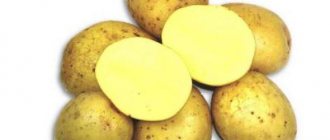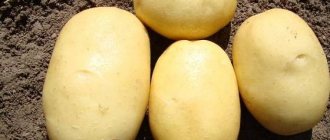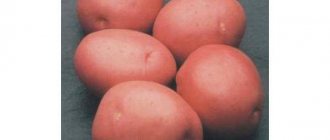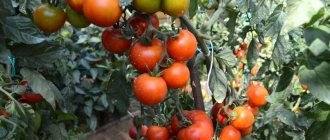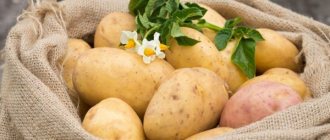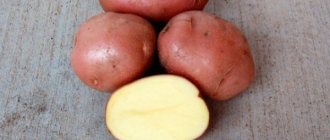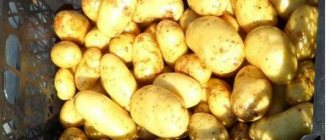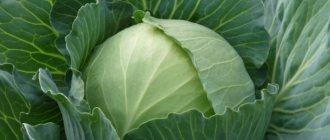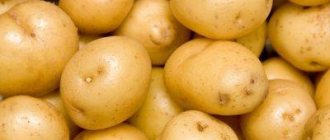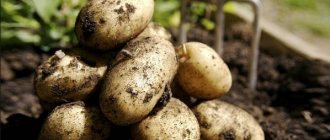Vegetable growing » Potatoes
0
2159
Article rating
Kira Stoletova
Labadia potatoes are a popular Dutch high-yielding table variety. The variety is quite new (it was introduced into the State Register only in 2012), but in this short time it has managed to fall in love with many gardeners. We will consider a more detailed description of the variety in the article.
Characteristics of Labadiya potato variety
Characteristics of the variety
Labadia potatoes are a medium-ripening variety that allows you to harvest a good harvest in a short time. In comparison with “Latona” and “Gala”, with proper care, after 70-90 days of the growing season, the gardener can only count on large vegetable tubers.
Labadia takes root best in the Central, Eastern and Northern regions of Russia, rich in chernozem soil. Other directions for it can be acceptable only in the case of a temperate climate and fertile soil. A dry and hot climate without precipitation, sand and soil without useful microelements are considered unacceptable and can lead, if not to the death of the crop, then to its reduction, both in quantity and size.
The taste of potatoes does not differ from the classic ones that all people who use them in their daily diet are accustomed to. Therefore, you don’t have to worry that when harvesting, the gardener will receive, instead of the usual taste that is in harmony with meat, fish and vegetable dishes, a reminder of fruit and berry notes.
Another advantage of the new variety is long-term storage without germination in the cellar. Supplies for the winter period are well stored in bags without being subject to rot. They can be left for several months, forgetting about sorting and sifting out spoiled tubers.
Potatoes "Labadia": characteristics, planting and care
It's hard to imagine a garden without potatoes. This vegetable is perhaps the most popular among gardeners and others. This culture is widespread in every region of our country and is consumed year-round. The variety of potato varieties on the market is very extensive. Different taste, shape, size, yield and many other factors distinguish them from each other. It is quite difficult to choose the best option for growing among such variety. The variety “Labadia” for table use is considered one of the best.
Description of the variety
It is important for an experienced gardener to know not only the benefits of the plant, but also its exact description. After all, it can clearly demonstrate whether the plant is healthy or not. Based on the shape of the stem, leaves and colors, not only an experienced gardener, but also a novice gardener can determine and provide assistance in a timely manner.
The characteristics of a vegetable crop are qualified by seven main indicators:
1) a large bush, characterized by a reclining standing position; 2) stem - powerful, developed according to vegetative time; 3) large leaves - with uneven, slightly wavy edges; 4) the plant, except for flowering, is colored in a rich light green tone; 5) unlike other parts of the potato, the corolla is small; 6) blooms - white, noticeably standing out against the background of greenery; 7) shoots - smooth, identical.
Description of potato fruit
Labadia, unlike other varieties, can produce from 7 to 11 potatoes on one bush. With proper care and absence of diseases, fruits are born large, round, slightly elongated in shape. The weight of each potato can reach from 95 to 160 grams. The eyes on the fruits are small but deep. The skin, although thin, is very rough, having a muted brownish-yellow tint. When cut, the flesh is warm, creamy in color.
Important!
The starch content in the tuber is no more than 20% of the total weight.
Many gardeners, when growing Labadia, have noted that the description of the fruit does not always correspond to reality. Depending on the frequency of watering, weather and quality of care, the harvest may differ from the specified standards from 10 to 30 percent, both up and down.
Advantages and disadvantages
| Advantages | Flaws |
| Excellent commercial properties: large, one-dimensional tubers, light, slightly rough skin texture; keeping quality and transportability | Tubers planted without light sprouts germinate slowly. Mandatory germination period |
| Pleasant taste | Do not plant early in cold soil |
| High stable yield | Prone to external mechanical damage, but the dense structure remains without flaws |
| Tolerates drought. Adapts to different soils | |
| The variety is resistant to dangerous potato diseases |
Landing
Labadia potatoes, according to reviews from many gardeners, should only be grown in pre-fed soil, regardless of its structure. It is best if, at the time of digging the furrow, the soil acidity is between pH 5.3 and 6.2. You can check the acid balance using test strips or in the laboratory by sending a soil test for testing. Another option for measuring pH has long been considered the germination of medicinal plants in beds. If coltsfoot, dandelions, daisies or clover sprouted on the ground without deliberate sowing, the soil was used without fertilizing.
The secret of productivity!
Many people know that potatoes cannot be planted in the same place every year. However, it has been verified that if you fertilize the soil in the fall with horse manure or superphosphate, digging up the rotting potato crop with soil, the next year’s crop will grow no worse than last year’s.
It is better to plant tubers in stable weather, when the air temperature does not drop below 8-12 degrees Celsius.
Harvesting and storage
The Labadia potato harvest ripens in 70–85 days, so if planted in May, potatoes can be dug up in late August or early September. About a week before, green or already slightly yellowed tops need to be mowed so that the potatoes in the ground are covered with a denser skin.
We advise you to find out when is the best time to dig potatoes for storage.
The dug up tubers are laid out on the site and ventilated, after which they are dried in dark rooms and stored in boxes or bags, having previously sorted them by size. You should not leave potatoes in the garden for a long time, especially if potato moths have already been noticed in this area.
In general, the process of growing the Labadia variety will not require excessive effort from you, and the result will certainly please any gardener: the effort spent will be fully compensated by tasty and healthy fruits of universal use.
Complete care
To avoid difficulties with the germination of bushes and tubers, you should pay close attention to the care of Labadia. Despite the unpretentiousness of the fresh crop, reviews from photos indicate that careful care is still necessary. With prolonged gardener indifference, the plant can be susceptible to serious problems, such as: potato moth, scab, rot and even late blight. Therefore, at least once every two weeks, the soil is loosened using a small rake, allowing oxygen to penetrate the root system. In addition to this point, do not forget about the weeds that periodically appear around tall bushes. If you ignore weeding, the vegetables will not receive the necessary sun.
If grown correctly, potatoes will grow like the ones in the photo.
In cloudy and sunny weather, heat and slush, do not forget about watering. If it is in short supply, flowering may not occur, and the plant may wither.
Diseases and pests
Labadia has fairly good immunity, but it is not protected from problems such as:
- late blight;
- scab;
- brown bacterial rot of potatoes;
- potato moth.
Late blight
When infected with this fungus, dark spots appear on the stems and leaves. Later they turn into a gray coating. In humid climates, it takes 10 days for the fungus to take over the entire area. As a preventative measure, special fungicides are used, which are used to treat the tubers shortly before planting begins.
Scab
Affects tubers. The potato shell becomes covered with brown or black spots. When tubers are affected by scab, the level of starch in the composition decreases. The ideal conditions for the growth of this fungus are high temperatures. It is very difficult to cure this disease, since if the area has been affected by the fungus, then its activity on it will continue for at least three years.
We recommend reading: “Description of the Granada potato variety”
Brown bacterial rot
If a crop is affected by this disease, then during flowering the tops begin to wither and the leaves turn yellow. If you harvest and place the tubers in a basement or cellar, they will still rot. If the site has been infected with brown bacterial rot, then potatoes cannot be planted on it for 5 years.
Potato moth
A serious pest that can ruin the entire crop. Potato moths are similar to regular moths. But it is not the butterflies that cause damage to the crop, but their larvae. To get rid of parasites, special insecticides are used. Also, hilling helps fight moths.
Fertilizer
If you want to help Labadia potatoes grow, you should feed the young plant moderately. Feeding should begin during the active growth phase, several weeks before flowering. You can repeat the process after 14-18 days.
Horse and bird manure has always been considered the best fertilizer. True, if it is not always possible to get the second one, the first one can be bought for a nominal fee at the stables or through an advertisement in the local newspaper.
An analogue of manure will be a solution of superphosphate mixed with water or wood ash scattered around each bush.
How to choose seed potatoes
You can purchase or order seed potatoes almost anywhere, from a spontaneous market to direct sale in a garden center. It is worth saying that vegetables are usually sold in nets made of woven material, which plays into the hands of the buyer. The fact is that in this case you can clearly see all the shortcomings and disadvantages, such as rotten vegetables, cuts or chips on the crop. If there are any, it is better to choose another bag.
It is worth saying that buying on a spontaneous market may turn out to be extremely unprofitable for you. There is no way for you to know for sure which potatoes are in the net. It may very well be that what you are looking at is not a seed potato, which belongs to the first or even the second reproduction, but one that has already degenerated or is affected by parasites or diseases. From this point of view, it is worth purchasing potatoes at specialized points of sale of an agricultural company, where each grid will have a certificate indicating the name of the variety, as well as information about the order of reproduction. In addition, the company often includes information about care, propagation and cultivation with the net, and also grows potatoes to order.
Photo reviews about the variety
- Elena Igorevna, 48 years old
For many years I planted different varieties of potatoes, but no one gave such a rich harvest as Labadia. Having planted only 10 kg of tubers, I dug up about 40, smooth and beautiful potatoes. And believe it or not, I got such a result without careful care. For the entire time, I only watered it and sprayed it twice against the Colorado potato beetle.
- Valery Olegovich, 41 years old
I have been planting Labadia potatoes for myself for 5 years now. It was only in the last year that the harvest failed. Apparently it's time to change the landing site...
- Irina Vladimirovna, 39 years old
I like the Labadia variety’s good yield and excellent taste, incomparable to our varieties. Having tried these potatoes for the first time at a party, I decided to ask my friends what kind of miracle they had grown. Having learned that this is Labadia, I decided to plant this variety on my plot this year... all I have to do is wait for the opening of the summer season!
Description of the Labadia potato variety with photos and reviews deserves special attention from land owners. High yield, regardless of novelty and Dutch origin, gets along well on Russian soil, without requiring daily care.
Features of cultivation
Preparing for landing
The plot for Labadiya potatoes begins to be prepared in the fall. It is advisable to choose it taking into account crop rotation. The part of the garden where winter crops, cabbage, beets or carrots grew is best. You cannot plant these potatoes where crops of the nightshade family were grown. Weeds and remains of cultivated plants are removed from the selected location, the soil is dug up to a depth of 25-30 cm (at the tip of a shovel), and fertilized with organic matter. If the plot is large, agricultural machinery is used.
Planting material is usually prepared in the spring, about a month before planting in the ground. First, it is necessary to select medium-sized tubers from the total mass without mechanical damage, traces of pest activity, symptoms of disease, rot, etc. Since the variety is distinguished by such a feature as long awakening of seedlings, planting material must be germinated for at least 3 weeks in a bright room. A day before planting, the tubers are disinfected - bathed in a weak solution of potassium permanganate. To improve their germination, you can use a growth stimulator. Gumiplant, Regoplant, Poteytin or any analogue of these drugs will do.
Planting time and technology
Frosts negatively affect the development of plants, so planting should not be rushed. It is important that the earth warms up to at least 8 degrees. In the southern regions, planting work begins in the second half of April, in the middle zone - from mid-May, and in the Urals, gardeners usually have to wait until the very end of spring. The indicated dates are approximate; they may be shifted in time depending on weather conditions.
The planting pattern is standard: the interval between holes is 35 cm, the row spacing is 65-70 cm, the depth of planting tubers is 8-10 cm. In small areas, you can plant potatoes under a shovel, but in large areas you cannot do without equipment. To keep the potato beds even and neat, you should use marker pegs. Compliance with all these recommendations guarantees friendly shoots.
Plant care
Labadia is an unpretentious variety, but to increase the quantitative and qualitative indicators of the harvest, some agrotechnical techniques should be carried out. Loosening is carried out first; it is necessary to improve the moisture and air permeability of the soil. The first time - a week after planting, all subsequent times - as the upper layers of the soil compact. The formation of a crust must not be allowed, otherwise the plant roots will not receive the required amount of moisture and air, which will negatively affect their development. Loosening is combined with weed removal.
The next technique is hilling. The first time it is carried out when the young bushes rise 15 cm above the ground. After 3 weeks, the procedure is repeated. You can hill up a third time, shortly before flowering begins. Some gardeners believe that two hillings are more than enough. They are partly right, but in reality it all depends on the weather. If rain and wind have destroyed the clumps under the plants, there is a risk of getting a crop of “green” potatoes (turned green as a result of chemical reactions that occur under the influence of sunlight). Green tubers with excessive solanine content are unsuitable for consumption.
Whether or not to water potato plantings is up to each gardener to decide for himself, based on weather conditions. Rainy weather eliminates this procedure, but if it is hot and the tops begin to lose their elasticity, watering is extremely necessary. Especially in the flowering phase, because during this crucial period plants need a lot of moisture. Potatoes of the Labadia variety should be watered competently, without unnecessary zeal, since stagnation of moisture can provoke the development of diseases. To saturate the entire fertile layer, 10-15 liters of water per square meter is enough.
Labadia responds well to fertilizing, so experts recommend fertilizing even on the most fertile soils. The first feeding is carried out a month after planting, the second, as a rule, is combined with watering during the active formation of buds. You can fertilize:
- infusion of manure and chicken droppings (watering between rows);
- potassium sulfate and wood ash diluted in water (under a bush);
- superphosphate solution (under the bush).
Before using store-bought fertilizers, you should carefully read the manufacturer's instructions, since an excess of some components causes the accumulation of nitrates in tubers.
Secret: how to rejuvenate potatoes
How to make high-quality planting material from degenerate potatoes that will give you a bucket of potatoes from one bush. In this video you will see how to rejuvenate and revive any variety of potato.
A few words about diseases and pests
It was mentioned above that Labadia is immune to golden nematode and potato cancer, but besides them, there are other serious diseases. The most dangerous for this variety are:
- fungal – Alternaria, Rhizoctonia, Phoma;
- bacterial - ring rot, brown rot, black leg;
- viral – tuber necrosis, speckled mosaic and others.
Preventive measures will help to avoid unpleasant and loss of part of the crop. This includes pre-planting treatment of tubers, compliance with crop rotation, correct planting patterns, regular loosening of the soil and removal of weeds, moderate watering, and moisture control. If a problem does arise, special medications will help eliminate it. For example, to get rid of late blight, gardeners spray the bushes with Fitosporin. It can also be used for preventive purposes.
Labadia potatoes are susceptible to attacks by pests, the worst of which is the Colorado potato beetle. It multiplies very quickly, so you need to inspect the plantings every day for the presence of this insect or its larvae. The latter are most often “hidden” on the inside of the leaf plate. They can be collected manually, just like adult insects, and then destroyed outside the site.
Potato moth is another serious enemy of Labadia potatoes. The above-ground parts of plants and tubers suffer not so much from it itself, but from its larvae. To avoid the appearance of this uninvited guest on the site, hill up the bushes high enough. If it appears in the garden, the plants can be sprayed with insectoacaricidal agents BI-58 New or DI-68.
